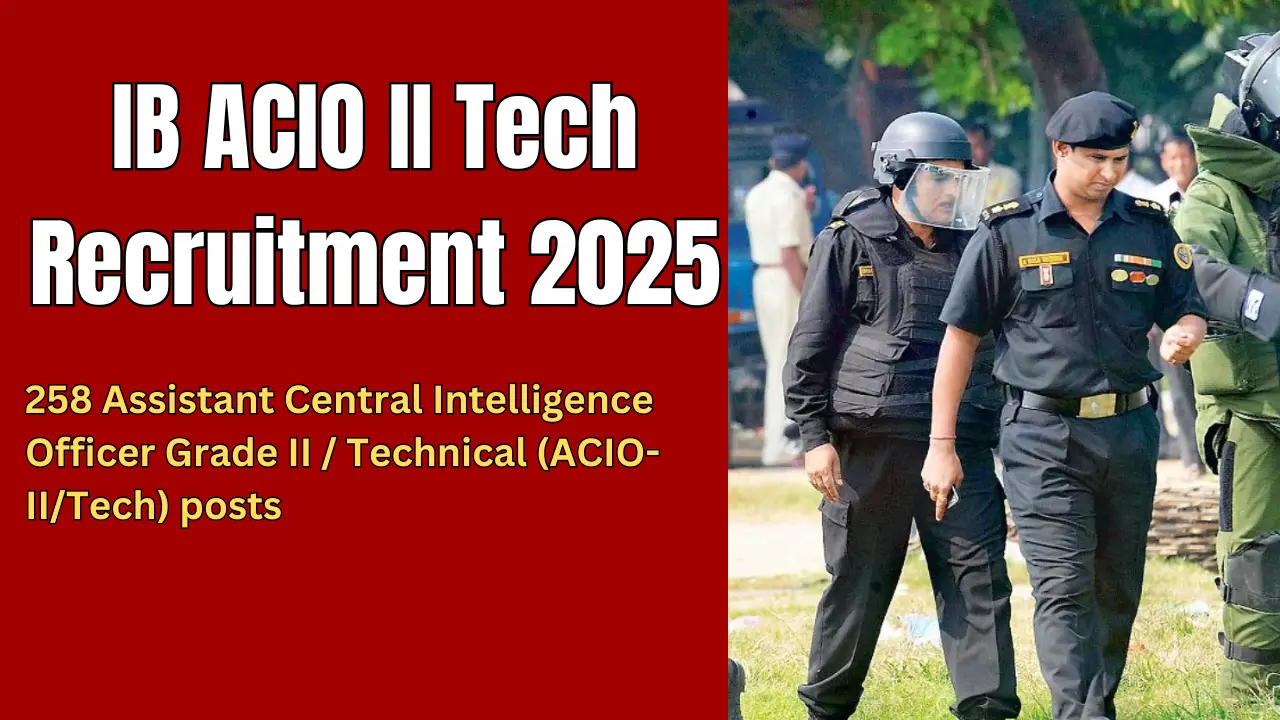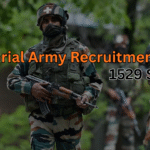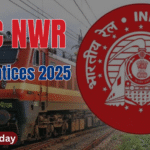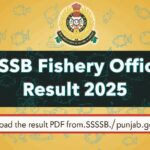Welcome to ‘The Punjab Jobs’ here we are providing the (Railway Recruitment Board Junior Engineer) RRB Syllabus 2024 including JE, DMS, CMA, and other posts.
The following steps will be included in the recruitment process:
- Computer-based test (CBT – 1)
- Computer-based test (CBT – 2)
- Document Verification (DV)
- Medical Examination (ME)
First stage computer-based test (CBT-1) Syllabus
The first stage of the CBT is screening in nature, and the questions on the test will normally be in line with the minimal technical requirements and/or educational requirements listed for the positions. Only the short list of applicants for the second-stage exam based on merit will be selected using the normalized first-stage exam score. PwBD and ExSM candidates who make it to the second stage of the CBT and who are eligible for a community’s reservation benefits will only be evaluated against that community in the next stages of the recruitment process. The multiple-choice questions will be objective and likely include the following topics:
A. Mathematics
Number systems; BODMAS, Algebra; Geometry; Trigonometry; Elementary Statistics; Age Calculations; Decimals; Fractions; LCM and HCF; Ratio and Proportion; Percentages; Mensuration; Time and Work; Time and Distance; Simple and Compound Interest; Profit and Loss; Square Root; Calendar & Clock; Pipes & Cistern.
B. General Intelligence and Reasoning:
Number and Alphabetical Series, Analogies jumbling, Venn diagram, syllogism, relationships, coding and decoding, mathematical processes, Interpretation and Sufficiency of Data Conclusions and Judging, Comparing and Contrasting, Classification, Directions, Statement-Arguments, Analytical reasoning, and
Presumptions, etc.
C. General Awareness:
This includes understanding current events, Indian geography, culture, and history, including the liberation fight, Indian economy, Indian politics and constitution, global environmental issues impacting India, sports, general scientific and technology advancements, etc.
D. General Science
(up to 10th Standard CBSE syllabus), including Physics, Chemistry, and Life Sciences. The number of questions and marks broken down by part are as follows:
| Subjects | No. of Questions | Marks for each Section |
| CBT-I | CBT-I | |
| Mathematics | 30 | 30 |
| General Intelligence & Reasoning | 25 | 25 |
| General Awareness | 15 | 15 |
| General Science | 30 | 30 |
| Total | 100 | 100 |
| Time in Minutes | 90 |
Second Stage CBT -2
Based on their normalized first-stage CBT exam scores, candidates will be shortlisted for the second stage of the exam. According to their performance in the first stage of CBT, a total of 15 times the number of community-wise post vacancies announced against the RRB will be shortlisted for the second stage. However, in order to guarantee that there are enough applicants for every post that has been announced, Railways has the right to raise or lower this cap overall or for any one or more particular categories.
Syllabus: The questions will be multiple-choice, objective-type questions covering topics such as general awareness, physics, chemistry, computer basics and applications, environment and pollution control, and technical skills relevant to the position. All notified posts under this CEN have the same syllabus for General Awareness, Physics and Chemistry, Basics of Computers and Applications, Basics of Environment, and Pollution Control, as shown below:
A) General Awareness: Information on current events, Indian geography, culture, and history, including the freedom movement, Indian economy, Indian Polity and Constitution, environmental challenges impacting both India and the rest of the world, sports, and general scientific and technological advancements, among other topics.
B) Up to the tenth standard CBSE syllabus for physics and chemistry.
The architecture of computers, input and output devices, storage devices, networking, operating systems including Windows, Unix, and Linux, Microsoft Office, various data representation, the Internet and email, websites and web browsers, and computer viruses are all covered in c) Fundamentals of Computers and Applications.
C) Understanding the Basics of the Environment and Pollution Control: This section covers the following topics: Waste Management, Global Warming, Acid Rain, Ozone Depletion, Adverse Effects of Environmental Pollution and Control Strategies, Air, Water, and Noise Pollution, Their Effects and Control Strategies.
E) Technical Abilities: The educational requirements listed in Annexure-A for each post have been divided into the following exam groups based on their respective qualifications. The syllabus for the different Exam Groups listed in Annexure VII—A, B, C, D, E, and F—will include questions on technical ability.
Below are the questions and marks broken down by section:
| Subjects | No. of Questions | Marks for each Section |
| CBT-II | CBT-II | |
| General Awareness | 15 | 15 |
| Physics & Chemistry | 15 | 15 |
| Basics of Computers and Applications | 10 | 10 |
| Basics of Environment and Pollution Control | 10 | 10 |
| Technical Abilities | 100 | 100 |
| Total | 150 | 150 |
| Time in Minutes | 120 |
Syllabus for Civil & Allied Engineering Exam Group– JE
- Engineering Mechanics
- Force: resolution, moment, system, composition
- Equilibrium
- Friction
- Centroid and Center of gravity
- Simple machines
- Building Construction
- Building components: substructure, superstructure
- Types of structures: load-bearing, framed, composite
- Building Materials
- Masonry materials: stones, bricks, mortars
- Timber and miscellaneous materials: glass, plastic, fiber, aluminum, steel, galvanized iron, bitumen, PVC, CPVC, PPF
- Construction of Substructure
- Job Layout
- Earthwork
- Foundations: types, dewatering, coffer dams, bearing capacity
- Construction of Superstructure
- Stone masonry, brick masonry, hollow concrete block masonry, composite masonry, cavity wall
- Doors and windows
- Vertical communication: stairs, lifts, escalators
- Scaffolding and shoring
- Building Finishes
- Floors: finishes, laying process
- Walls: plastering, pointing, painting
- Roofs: roofing materials including RCC
- Building Maintenance
- Cracks: causes, types, repairs (grouting, guniting, epoxy, etc.)
- Settlement: causes, remedial measures
- Re-baring techniques
- Building Drawing
- Conventions: types of lines, symbols
- Planning: principles for residential and public buildings, rules, bye-laws
- Drawings: plan, elevation, section, site plan, location plan, foundation plan, working drawing, perspective drawing
- Concrete Technology
- Properties of various types/grades of cement
- Properties of coarse and fine aggregates
- Concrete properties: water-cement ratio, properties of fresh and hardened concrete
- Concrete mix design
- Testing and quality control of concrete
- Extreme weather concreting, chemical admixtures
- Properties of special concrete: ready mix, RCC, pre-stressed, fiber reinforced, precast, high-performance
- Surveying
- Types of survey
- Chain and cross-staff survey
- Compass survey
- Leveling
- Contouring
- Area and volume measurements
- Plane table survey
- Theodolite survey
- Tacheometric survey
- Curves: types, setting out
- Advanced survey equipment
- Aerial survey and remote sensing
- Computer Aided Design
- CAD Software: AutoCAD, Auto Civil, 3D Max, etc.
- CAD commands
- Generation of plan, elevation, section, site plan, area statement, 3D view
- Geo Technical Engineering
- Application in design of foundations, pavements, earth retaining structures, earthen dams, etc.
- Physical properties of soil
- Permeability of soil and seepage analysis
- Shear strength of soil
- Bearing capacity of soil
- Compaction and stabilization of soil
- Site investigation and sub-soil exploration
- Hydraulics
- Properties of fluid
- Hydrostatic pressure
- Measurement of liquid pressure in pipes
- Fundamentals of fluid flow
- Flow of liquid through pipes and open channels
- Flow measuring devices
- Hydraulic machines
- Irrigation Engineering
- Hydrology
- Investigation and reservoir planning
- Percolation tanks
- Diversion headworks
- Mechanics of Structures
- Stress and strain
- Shear force and bending moment
- Moment of inertia
- Stresses in beams
- Analysis of trusses
- Strain energy
- Theory of Structures
- Direct and bending stresses
- Slope and deflection
- Fixed beam, continuous beam, moment distribution method, columns
- Design of Concrete Structures
- Working Stress method, Limit State method
- Analysis and design of singly and doubly reinforced sections
- Shear, bond, and development length
- Analysis and design of T Beam, slab, axially loaded column, and footings
- Design of Steel Structures
- Types of sections, grades of steel, strength characteristics, IS Code
- Connections
- Design of tension and compression members, steel roof truss, beams, column bases
- Transportation Engineering
- Railway Engineering: alignment and gauges, permanent way, track geometrics, branching of tracks, stations and yards, track maintenance
- Bridge Engineering: site selection, investigation, component parts of bridge, permanent and temporary bridges, inspection and maintenance
- Tunnel Engineering: classification, shape and sizes, tunnel investigation and surveying, method of tunneling in various strata, precautions, equipment, explosives, lining, and ventilation
- Highway Engineering
- Road Engineering
- Investigation for road project
- Geometric design of highways
- Construction of road pavements and materials
- Traffic engineering
- Hill roads
- Drainage of roads
- Maintenance and repair of roads
- Environmental Engineering
- Environmental pollution and control
- Public water supply
- Domestic sewage
- Solid waste management
- Environmental sanitation and plumbing
- Advanced Construction Techniques and Equipment
- Fibers and plastics, artificial timber
- Advanced concreting methods: underwater concreting, ready mix concrete, tremix concreting, special concretes
- Formwork
- Prefabricated construction
- Soil reinforcing techniques
- Hoisting and conveying equipment
- Earth moving machinery: excavation and compaction equipment
- Concrete mixers, stone crushers, pile driving equipment
- Working of hot mix bitumen plant, bitumen paver, floor polishing machines
- Estimating and Costing
- Types of estimates: approximate, detailed
- Mode of measurements and rate analysis
- Contracts and Accounts
- Types of Engineering Contracts
- Tender and tender documents
- Payment specifications
Syllabus for Electrical & Allied Engineering Exam Group– JE
- Basic Concepts
- Resistance, inductance, capacitance, and factors affecting them
- Current, voltage, power, energy, and their units
- Circuit Law
- Kirchhoff’s law
- Simple circuit solutions using network theorems
- Magnetic Circuit
- Flux, mmf, reluctance
- Types of magnetic materials
- Magnetic calculations for various conductor configurations (straight, circular, solenoidal)
- Electromagnetic induction, self, and mutual induction
- AC Fundamentals
- Instantaneous, peak, RMS, and average values of alternating waves
- Representation of sinusoidal waveform
- Simple series and parallel AC circuits with R, L, and C
- Resonance, tank circuit
- Polyphase systems: star and delta connections, three-phase power
- DC and sinusoidal response of R-L and R-C circuits
- Measurement and Measuring Instruments
- Measurement of power (single-phase and three-phase, both active and reactive)
- Measurement of energy
- Two-wattmeter method for three-phase power measurement
- Measurement of frequency and phase angle
- Ammeters and voltmeters (moving coil and moving iron types)
- Extension of range wattmeter, multimeters, megger, energy meter, AC bridges
- Use of CRO, signal generator, CT, PT, and their uses
- Earth fault detection
- Electrical Machines
- DC Machines: Construction, basic principles of motors and generators, characteristics, speed control, starting methods, braking methods, losses, and efficiency
- Transformers: Construction, principles of operation, equivalent circuit, voltage regulation, OC and SC tests, losses, efficiency, effects of voltage, frequency, and waveform on losses, parallel operation, autotransformers
- Three-phase Induction Motors: Rotating magnetic field, principle of operation, equivalent circuit, torque-speed characteristics, starting and speed control, braking methods, effects of voltage and frequency variations, fractional kilowatt motors, single-phase induction motors (characteristics and applications)
- Synchronous Machines
- Generation of three-phase EMF, armature reaction, voltage regulation
- Parallel operation of alternators, synchronizing, control of active and reactive power
- Starting and applications of synchronous motors
- Generation, Transmission, and Distribution
- Types of power stations, load factor, diversity factor, demand factor, cost of generation, interconnection of power stations
- Power factor improvement, types of tariffs, types of faults, short circuit current for symmetrical faults
- Switchgear and protection: circuit breaker ratings, principles of arc extinction (oil and air), HRC fuses, protection against earth leakage and overcurrent, Buchholz relay, Merz-Price system (protection of generators and transformers), protection of feeders and bus bars, lightning arresters
- Transmission and distribution systems, comparison of conductor materials, efficiency of different systems
- Cables: types, rating, and derating factor
- Estimation and Costing
- Estimation of lighting schemes, electric installation of machines, relevant IE rules
- Earthing practices and IE rules
- Utilization of Electrical Energy
- Illumination
- Electric heating
- Electric welding
- Electroplating
- Electric drives and motors
- Basic Electronics
- Working of electronic devices: PN junction diodes, transistors (NPN and PNP types), BJT, JFET
- Simple circuits using these devices
Syllabus for Electronics & Allied Engineering Exam Group– JE
- Electronic Components & Materials
- Conductors, semiconductors, insulators
- Magnetic materials
- Jointing and cleaning materials for U/G copper cable and OFC
- Cells and batteries (rechargeable and non-rechargeable)
- Relays, switches, MCBs, connectors
- Electronic Devices and Circuits
- PN junction diodes, thyristors
- Diode and triode circuits
- Junction transistors
- Amplifiers
- Oscillators
- Multivibrators, counters
- Rectifiers
- Inverters and UPS
- Digital Electronics
- Number system and binary codes
- Boolean algebra and logic gates
- Combinational and sequential logic circuits
- A/D and D/A converters
- Counters
- Memories
- Linear Integrated Circuit
- Introduction to operational amplifiers
- Linear applications
- Non-linear applications
- Voltage regulators
- Timers
- Phase-locked loops
- Microprocessor and Microcontroller
- Introduction to microprocessors
- 8085 microprocessor working
- Assembly language programming
- Peripherals and other microprocessors
- Microcontrollers
- Electronic Measurements
- Measuring systems
- Basic principles of measurement
- Range extension methods
- Cathode ray oscilloscope
- LCD and LED panels
- Transducers
- Communication Engineering
- Introduction to communication
- Modulation techniques
- Multiplexing techniques
- Wave propagation
- Transmission line characteristics, OFC
- Fundamentals of public address systems
- Electronic exchanges
- Radar
- Cellular and satellite communication
- Data Communication and Network
- Introduction to data communication
- Hardware and interfaces
- Introduction to networks and networking devices
- Local area network (LAN) and wide area network (WAN)
- Internetworking
- Computer Programming
- Programming concepts
- Fundamentals of C and C++
- Operators in C and C++
- Control statements
- Functions, arrays, strings, pointers
- File structure
- Data Structures and DBMS
- Basic Electrical Engineering
- DC circuits
- AC fundamentals
- Magnetic, thermal, and chemical effects of electric current
- Earthing: installation, maintenance, testing
- Engineering Mechanics
- Resolution of forces, equilibrium and equilibrant
- Parallelogram law of forces, triangle law of forces, polygon law of forces, and Lami’s theorem
- Couple and moment of a couple
- Condition for equilibrium of rigid bodies subjected to coplanar non-concurrent forces
- Static and dynamic friction, limiting angle of friction, and angle of repose
- Resolution of forces considering friction on horizontal and inclined planes
- Calculation of moment of inertia and radius of gyration for I-section, channel section, T-section, L-section (equal & unequal lengths), Z-section, and built-up sections
- Newton’s laws of motion, motion of projectile, D’Alembert’s principle
- Laws of conservation of energy and momentum
- Material Science
- Mechanical properties of engineering materials: tensile strength, compressive strength, ductility, malleability, hardness, toughness, brittleness, impact strength, fatigue, creep resistance
- Classification of steels, mild steel, and alloy steels
- Importance and processes of heat treatment: annealing, normalizing, hardening, tempering, carburizing, nitriding, cyaniding
- Strength of Materials
- Stress, strain, stress-strain diagram, factor of safety, thermal stresses
- Strain energy, proof resilience, modulus of resilience
- Shear force and bending moment diagrams for cantilever, simply supported, continuous, and fixed beams
- Torsion in shafts and springs, thin cylindrical shells
- Machining
- Working principle of lathes, types, construction details, and specifications
- Nomenclature and geometry of single-point cutting tools, tool signature, functions of tool angles
- General and special lathe operations: turning, facing, taper turning, thread cutting, knurling, forming, drilling, boring, reaming, keyway cutting
- Cutting fluids, coolants, and lubricants
- Introduction to shapers, slotters, planers, broaching, milling, gear manufacturing, and heat treatment processes applied to gears
- Welding
- Introduction and classification of welding processes, advantages and limitations
- Principles and equipment of arc welding and gas (oxy-acetylene) welding
- Choice of electrodes, welding procedures (arc and gas), soldering and brazing techniques
- Types and applications of solders and fluxes, flame cutting processes
- Welding defects, testing and inspection
- Modern welding methods: submerged, CO2, atomic-hydrogen, ultrasonic welding, MIG, and TIG welding
- Grinding & Finishing Processes
- Principles of metal removal by grinding, abrasives (natural and artificial), bonds and binding processes
- Grinding machines: cylindrical, surface, tool & cutter grinding machines, construction details
- Principles, advantages, and limitations of centerless grinding
- Workholding devices, wheel maintenance, balancing, coolants
- Finishing by grinding, honing, lapping, super finishing, electroplating
- Basic principles and applications of plating metals, hot dipping, galvanizing, tin coating, parkerizing, anodizing, metal spraying
- Organic coatings: oil-based paint, lacquer-based enamels, bituminous paints, rubber-based coatings
- Metrology
- Linear measurements: slip gauges, dial indicators
- Angle measurements: bevel protractor, sine bar, angle slip gauges
- Comparators: mechanical, electrical, optical, pneumatic
- Measurement of surface roughness by comparison, tracer instruments, interferometry
- Collimators, measuring microscope, interferometer
- Inspection of machine parts using shadow projection and profile projection concepts
- Fluid Mechanics & Hydraulic Machinery
- Properties of fluid: density, specific weight, specific gravity, viscosity, surface tension, compressibility, capillarity
- Pascal’s law, measurement of pressures, buoyancy concept
- Reynold’s number, pressure, potential and kinetic energy of liquids, laws of conservation of mass, energy, and momentum
- Bernoulli’s equation, venturi meters, pitot-tube, current meters
- Working principles and construction details of centrifugal pumps, efficiencies, cavitation
- Working principles of jet and submersible pumps
- Industrial Management
- Job analysis, motivation theories, satisfaction, performance reward systems
- Production planning and control, routing, scheduling, dispatching, PERT and CPM
- Inventory control models, ABC analysis, safety stock, reorder level, economic ordering quantity
- Break-even analysis, stores layout, stores equipment, stores records, purchasing procedures, purchase records
- Material handling: manual lifting, hoists, cranes, conveyors, trucks, forklifts
- Thermal Engineering
- Laws of thermodynamics, conversion of heat into work and vice versa
- Laws of perfect gases, thermodynamic processes (isochoric, isobaric, isothermal, hyperbolic, isentropic, polytrophic, throttling)
- Modes of heat transfer: conduction, convection, radiation, and overall heat transfer coefficient
- Air standard cycles: Carnot, Otto, Diesel cycles
- Construction and working of internal combustion engines, comparison of diesel and petrol engines
- Systems of internal combustion engines, performance analysis
- Air compressors, refrigeration cycles, principle of refrigeration plants
Syllabus for CMA Exam Group
- Measurements, Units and Dimensions
- Types of errors in measurements
- Significance of accuracy in measurement
- Light
- Basic principles: reflection, refraction, laws of reflection, total internal reflection, interference, diffraction, and polarization
- Formula for magnification of microscope and telescope
- Electromagnetic spectra
- Heat
- Heat as energy, sources of heat, transmission of heat
- Expansion of solids, liquids, and gases
- Temperature (based on thermal equilibrium), different scales of temperature
- Calorimetry, applications of specific heat, latent heat
- Anomalous expansion of water and its significance in nature
- Combustion, calorific value, specific heat of gases
- Sound
- Sources and propagation of sound
- Velocity of sound in different media/substances
- Characteristics of sound, reflection of sound, echo, resonance, sonar, and Doppler effect
- Mechanics
- Scalars and vectors, types of motion, friction, Newton’s laws of motion, momentum
- Equations of motion (under gravity and freely falling), projectile motion, range
- Laws of floatation, work, power, and energy, conservation of energy
- Center of mass, center of gravity, stability, and equilibrium
- Universal law of gravitation, relation between ‘g’ and ‘G’, circular motion, Kepler’s laws
- Elasticity and Hooke’s Law
- Magnetism
- Magnetic field, uniform and non-uniform magnetic fields, magnetic induction
- Magnetic lines of force, magnetic pole strength, magnetic moment
- Inverse square law of magnetism, magnetic properties of materials and their classification
- Electricity & Electromagnetism
- Electric charge, field, intensity, potential, and potential difference
- Simple electric circuits, conductors, non-conductors/insulators, Coulomb’s inverse square law
- Primary and secondary cells, Ohm’s law and its limitations, resistances in series and parallel, emf of a circuit, specific resistance
- Kirchhoff’s laws, relation between electric potential and electric energy, electric power (wattage)
- Heating effect of electric current, Joule’s law, Ampere’s law, circular loop and solenoid
- Magnetic force on moving charged particles and long straight conductors, Fleming’s left-hand rule, electric motor
- Electromagnetic induction (Faraday’s law), electromagnetic flux, Lenz’s law, generators, alternating currents
- Inductance (self and mutual) and principles of transformers
- Modern Physics
- Discharge of electricity through gases, cathode rays, anode rays and their properties, X-rays
- Atomic models: JJ Thomson, Rutherford, and Bohr’s models
- Atomic nucleus and its structure, mass defect, radioactivity, alpha, beta, and gamma radiations, applications, and decays
- Half-life period, isotopes, isobars, and isotones, artificial radioactivity, radioisotopes and their uses
- Radioactive series, chain and controlled nuclear reactions, fission and fusion of nuclei, atomic bomb, and hydrogen bomb
- Electronics and Communications
- Semiconductors, diode, p-n junction characteristics
- Transistors (pnp & npn) characteristics and uses, Zener diode characteristics
- Simple electronic circuits, logic gates applications, modulation, and demodulation
- Matter
- States of matter, elements, compounds, and mixtures
- Methods of separation of mixtures, chromatography
- Behavior and measurable properties of gases, gas laws
- Mole concept, Dalton, Avogadro, Berzelius laws
- Chemical Reactions
- Physical and chemical changes, types of chemical reactions
- Physical and chemical properties of various compounds
- Chemical calculations, common compounds (NaOH, bleaching powder, baking soda, washing soda) and their uses
- Plaster of Paris
- Acids, Bases, and Salts
- Strength and uses of acids and bases, neutralization, nature and uses of different salts
- Water of crystallization, complex, neutral and double salts, oxidation and reduction, rancidity
- Identification of acids and bases, indicators (natural, chemical), pH scale
- Role of pH in daily life (agriculture, medicine), classification of salts, examples of acidic, basic, mixed, complex, neutral and double salts
- Solutions: types, solubility, ionization, concentration, oxidation number concept, balancing of redox reactions, calculation of concentrations, stoichiometry
- Atomic Structure
- Electromagnetic spectrum, atomic spectrum, characteristics of electrons, protons, and neutrons
- Rutherford’s model of an atom, nature of electromagnetic radiation, Planck’s quantum mechanics, explanation of photoelectric effect
- Features of atomic spectra, characteristics of hydrogen spectrum, Bohr’s theory of atomic structure and spectral lines
- Wave-particle nature of electrons, de Broglie’s hypothesis, Heisenberg’s uncertainty principle
- Quantum mechanical model of an atom, quantum numbers, concept of orbitals
- Shapes of s, p, and d orbitals, (n + l) rule, Aufbau principle, Pauli’s exclusion principle, Hund’s rule of maximum multiplicity
- Electronic configuration of atoms, explanation of stability of half-filled and completely filled orbitals
- Periodic Classification of Elements
- Characteristics of elements in groups and periods, significance of atomic number and electronic configuration
- Classification of elements into s-block, p-block, d-block, f-block, and their main characteristics
- Periodic trends in physical and chemical properties of elements, study of different groups of the periodic table
- Chemical Bonding
- Ionic and covalent bonds, electronic configuration of noble gases
- Sigma and pi bonds with examples, shapes of molecules, bond lengths and bond angles
- Hybridization (H2O, BF3, CH4, NH3, etc.), hydrogen bonding and types of H bonds
- Carbon and its Compounds
- Need to study carbon compounds separately, classification of organic compounds
- Hydrocarbons: alkanes, alkenes, alkynes, aromatic and aliphatic compounds
- Bonding in carbon, hybridization, allotropes of carbon, versatile nature of carbon
- Tetravalency, chains, branches, and rings, catenation, isomerism, saturated and unsaturated carbon compounds
- Functional groups, homologous series, chemical properties (combustion, oxidation, addition reactions, substitution reactions)
- Important carbon compounds, nomenclature, carbohydrates, proteins, oils and fats, polymers (polythene, nylon, PVC, polyvinyl alcohol), rubber and its uses
- Environmental Chemistry
- Different types of pollution, acid rain, ozone reactions, effects of ozone layer depletion
- Greenhouse effect, global warming, green chemistry as an alternative tool for reducing pollution
- Metallurgy
- Occurrence of metals, minerals, ores
- Extraction of metals: activity series and related metallurgy, steps involved in metal extraction
- Refining metals, electrolytic refining, corrosion and its prevention, alloys and their uses
Syllabus for Chemical and Metallurgical Supervisor Exam Group
- Fuels
- Classification: Solid, Liquid, and Gaseous fuels
- Types: Coal, Metallurgical coke, Petroleum
- Gaseous Fuels: Producer Gas, Water Gas, Coal Oven Gas, Blast Furnace Gas, Natural Gas
- Material Science
- Atomic arrangement in materials
- Bonding in metals
- Corrosion
- Ferrous Metals: Mild steel, high carbon steel, stainless steel, high silicon steel, molybdenum and tungsten steel
- Nonferrous Metals: Copper, aluminium, lead, chromium, tin, brass, bronze, Monel
- Non-metals: Glass, enamels, chemical stone wares, graphite, wood, plastics, rubber, ebonite lining materials
- Engineering Polymers
- Polymers and polymerization
- Industrial polymers: Manufacturing and industrial applications
- Thermodynamics
- Laws of thermodynamics and their applications
- Heat transfer: Conduction, convection, radiation
- Refrigerating cycles
- Combustion cycle for internal combustion (I.C.) engines
- Applied Chemistry
- Water, cement, lubricants, explosives, and propellants
- Important industrial chemicals: Industrial method of preparation, properties, and major industrial uses of Ammonium Chloride, Ammonium Nitrate, Ammonium Sulphate, Calcium Phosphate (Super phosphate), Benzene (Benzol), Carbon Tetrachloride, Cresol, Ethyl Alcohol (Ethanol), Glycerine (Glycerol), and Melamine
- Applied Physics
- Friction, equilibrium of forces and couples
- Concepts of stress and strain
- Optics, basic digital electronics, nuclear physics, radioactivity
- Solid state physics: Semiconductors, diodes, transistors
- Electrical machines: D.C. motor, transformers
- Basic Computer Science – Hardware & Software
- Hardware, operating system, database management system
- Programming languages, networking, internet, and World Wide Web
- Instrumentation & Measurement
- Temperature and pressure measurement
- Energy, Environment & Ecology
- Sources of energy: Renewable and non-renewable
- Ecosystem: Cycles and biodiversity
- Pollution: Air, water, sound, soil/land and its management
- Basic Mechanical Engineering Mechanism
- Velocity analysis
- Transmission of motion by direct contacts: Gear trains, belt drives, stepped pulley, chain drive
- Strength of materials: Stress, strain, elasticity, thermal stress, torsion of a circular shaft, shearing force, and bending moment in beams
- Fluid mechanics: Fluid properties, Bernoulli’s equation and its applications, losses in pipe fittings, flow measurements
- Manufacturing processes: Casting, machining, forging, plastic deformation, and metal forming
- Welding
- Gas and arc welding
- Foundry: Pattern making, types and pattern allowances, core box and core prints, properties and composition of good mould, sand, moulding defects
- Basic Electrical Engineering
- Basic laws of electricity, various uses and effects of electricity, fuses, relays
- Principle of generation of electricity, electrical circuit analysis, transformers
- Basics of AC (three & single phase) and DC machines
- Semiconductors: Diodes, transistors (including junction transistors)
- Basic knowledge on rectifiers, filters, amplifiers, modulation, and demodulation
- Basic digital electronics
- Basic Civil Engineering
- Building materials: Stones, bricks, cement, lime, timber (types, properties, tests, and uses), laboratory tests
- Concrete and mortar materials
- Building construction: Foundations, RCC footings, brick masonry walls, plastering and pointing, floors, roofs, doors, windows, lintels, staircases
- RCC and steel structures
- Surveying: Instruments, measurement of distances, directions, elevations, mapping details, and contouring














